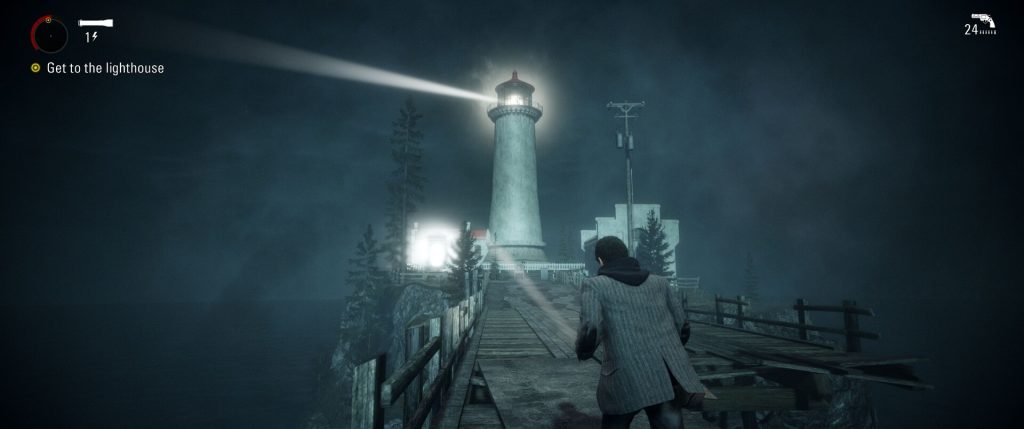Hello pack, this is QueerWolf and today I would like to talk with you about storytelling and video games.
When LazyFox and I decided to create owof, the first thing I did was to fill my head with tons of books, and I started reading this dissertation by Aaron A. Reed. The introduction contains a statement by Roger Ebert (a film critic) which can be summed up in “a story can be art only when in control of the author”. Video games take away the agency on the narrative from the author to give it to the player, and for this reason a video game will never be able to rise from the world of craftsmanship to become art.
My brain has been fixated on these words for weeks. They planted themselves in my head, an annoying itch that I want to solve with this post. Premise: I will use narrative and narration taking into account all aspects of the video game, not just the text (e.g., Le Andande is also a story, but there is not a word).
Beats, themes and accidents at the lighthouse
I get to the world of video games with a few decades of good and bad literary writing behind me, reflections on what it means to write fiction, and a lot of reading.
There are billions of theories on how to write a text, on what the basic rules are, each with its advantages and limitations.
Personally, when I write or analyze a work of fiction, central to me are the theme (which in brief answers the question: what is this story about?) and the authorial perspective (aka: what does the author think about this theme?).
The theme is like a lighthouse that indicates where to go, the authorial perspective is the why. The how depends on a set of conscious choices, afterthoughts and accidents, but everything will be fine as long as I remain within the cone of light of the lighthouse.
In Story, Robert McKee analyzes the structure of a story. Once again, briefly: the smallest element of the story, which McKee calls the beat, is the minimum change that can occur within a narrative, that is, some behavior in terms of action and reaction. Above the beat is the scene, which must bring about a transformation in the existential condition of a character, in a way that is relevant to the theme of the story. Above the scene is the sequence, which must bring a change with an emotional value and meaning greater than that of the scene, just as the change expressed by the act must have an even greater value than that of the sequence, and the story which must express the highest variation.
This creates a pyramid linked to the intensity and value of the change that considers the beat at the base and the story in its entirety at the top. Or, coming back to our lighthouse, the farther we are from the source, the more rarefied the light will be, which, just like the intensity and strength of the theme, will gradually increase until we end up crashing into the nature of the story and the lighthouse itself.
Simplifying, we can read a narrative as a succession of events connected by a common theme (events that are also actions, the verbs Anna Anthropy talks about in A game design vocabulary). These elements are the backbone of a story on which we can put descriptions, dialogues, connecting events and everything that can dictate the tone, the emotional and experiential aspect. We see it very well when we are faced with remakes, rereadings, reinterpretations: the Lion King traces its structure back to Shakespeare’s Hamlet, and even if the ways in which the two stories are expressed are different, the framework is the same.
This is why I believe that Ebert is wrong, and limits himself to observe the asphyxiated egomania of the author instead of looking at the breadth of perspectives that a story always contains within itself. He does not see an ocean, but just a flat and boring road.
When I write a story, once I have a clear theme and perspective, the choices I have available to build the story are limited only by my imagination, and mainly influenced by a mix of taste, style, irrationality, desire for evocation, and so on. Places, objects, relationships, things said and unspoken, hugs given and present donated are all things that rest on the main framework as if they were skin, hair, eyes; they create uniqueness, which is but one of the possible uniquenesses of that story.
What I can give to the player is precisely this set of elements: if I keep the sea in front of me under the light of the theme, I can trace a number of paths limited only by my imagination without affecting the quality of the story. It will be up to the player to choose whether to move in those waters with a boat, swimming, with a diving suit or riding a sentient marshmallow shark.

A practical example
These days with ASCARI we are getting back to work on our second project, non-binary (not yet translated). The current text and story do not give agency to the player because we only had two days to work on it, and we didn’t feel like making our lives more difficult back then. Now that we have more breathing room, the first thing we asked ourselves was exactly what kind of choices we can offer to the player.
At the beginning I got discouraged: theme, authorial perspective and non-binary context intertwined to create a very limited margin for maneuver at first glance. What is central is the language, the idea that without a language to define ourselves we can’t feel right, and that instead the outside world uses the words it has to suffocate us, hurt us, cancel us (but really cancel us, not like the ubiquitous JKR).
And above all, our protagonist does not even know why they feel bad, precisely because they doesn’t have the words to describe themself. The choices that strike us most are those that bring about a change, but in order to change I have to understand what is wrong and where I want to go, and our protagonist is missing these two information. In short: when the idea of the rewriting started I was like this:

Then I took a breath, and I relied on the theme. The theme allowed me to reflect on the situations in which it typically emerged. With LazyFox and ASCARI we decided to still sketch different circumstances along the main character’s life in order to show how pervasive the problem is (no, it’s not just “a phase”), gradually increasing the tension. Each moment will address a different aspect of the theme (e.g.: language and school, language and family, language and self-reflection), and since the dialogue aspect in this game is central, we will try to give a value to the characters that will occur throughout history.
This way, the player will be given the opportunity to make both “expressive” choices (therefore linked to the tone with which they will want to react to the context: will they try to support whoever is in front of them because they are a person they think very highly of or feel affection for? Will they claim the right to be themself instead? Will they do it with anger? In a diplomatic way?) and others which explicitly effect the story (will they remain close to those who continue to limit them?). All this, without risking that the story loses its way or its solidity, because no matter how the glow of the lighthouse will eventually lead us home.
Conclusion
Actually, I would like to say thousands of other things. The metaphor of the lighthouse has the flaw of giving the idea that there is only one point of arrival, which is obviously not true. Even before I started messing around with video games, when I played them I always loved to see the choices I’ve made lead to different endings (yes, I’m talking to you, Life Is Strange!). I would like to go back to what a choice is later on, the nature of the ramifications and so on.
The considerations up to here are just a beginning. The concept for the blogging section on owof comes from the idea of taking a journey with you. Personally, the hope is that coming from an environment other than that of programming or script (something that is common between many designers) can bring over time a useful perspective on the discourse.
I just hope that the reasons I think Ebert is wrong are clear: a video game has its nature and its objectives, its peculiarities and defects, but the transfer of control over the story doesn’t deprive it of value, nor does it take away the possibility of creating art.
Paws up.
Queer Wolf
